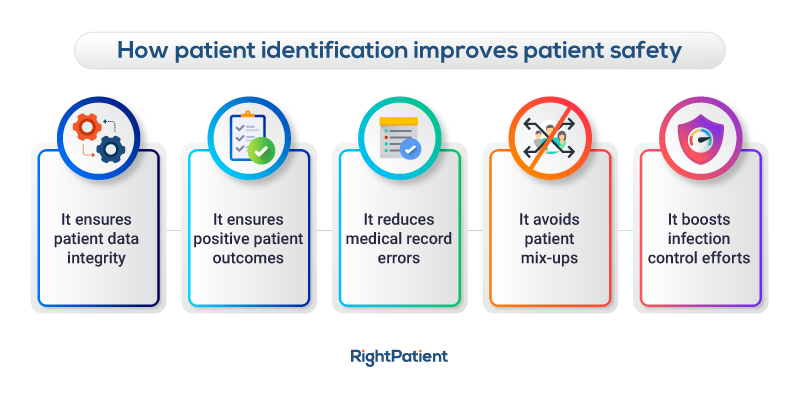Unraveling Patient Identification Challenges with RightPatient’s Biometric System

In the complex world of healthcare, accuracy in patient identification is paramount. A single error can result in life-threatening situations, not to mention the alarming financial implications. Shockingly, patient misidentification accounts for between 10-20% of all medical errors, and approximately 10% of hospital records are duplicates, costing between $1,000-$5,000 to resolve each one. On a larger scale, medical identity theft costs the healthcare industry an astronomical $50 billion per year. These issues are real, widespread, and costly. But there is a solution: RightPatient – a revolutionary biometric patient identification platform.
RightPatient is designed to tackle the prevalent and intricate challenges of patient identification. The platform is built on advanced biometric identification technology, aiming to resolve patient misidentification, enhance patient safety, and curb fraud within the healthcare industry.
Offering the flexibility of six distinct biometric types, RightPatient ensures the right patient is given the correct care, each and every time. This unique approach eliminates medical errors caused by misidentification and significantly reduces the incidence of duplicate records, a common issue that unnecessarily consumes hospital resources.
RightPatient also serves as a strong defense against medical identity theft. By implementing HIPAA-compliant identification methods, it heightens data security levels, instilling confidence in healthcare providers and patients alike. In turn, this allows healthcare providers to better protect patients and sensitive data.
However, RightPatient’s benefits extend beyond operational excellence. The platform also fosters a seamless patient experience. With the availability of contactless and mobile verification options, it instills trust and underscores a healthcare provider’s dedication to patient welfare.
Due to its cloud-based architecture, RightPatient ensures scalability, quick deployment, and effortless updates without the requirement of on-premises hardware. This innovative solution has earned the trust of hospitals across the country, demonstrating a proven ROI through substantial cost reductions and noticeable error minimization.
In conclusion, RightPatient is transforming the patient identification process, improving patient safety, decreasing fraud, and enhancing patient experience. Don’t just take our word for it, request a demo and see how RightPatient can revolutionize the way your hospital operates. For additional information about RightPatient, visit our page.
By merging technology with healthcare, RightPatient is not only addressing a critical issue but also paving the way for more secure, efficient, and patient-friendly healthcare services. It’s time to embrace this innovative solution and reinvent patient identification for the better because in healthcare, every patient has the right to be correctly identified and accurately treated. The RightPatient platform is the key to making this a reality.
How to Use RightPatient
- Request a Demo: Visit the RightPatient website and click on the 'Request a Demo' button. Fill out the form with your details and submit. A representative will get in touch with you shortly. You can request a demo here.
- Installation: Once you decide to proceed with RightPatient, our team will guide you through the installation process. The platform is cloud-based, so there's no need for on-premises hardware.
- Training: We provide comprehensive training to ensure your staff is well-versed with the platform.
- Using RightPatient: RightPatient is designed to be user-friendly. Patients can be identified using six distinct biometric types, ensuring accurate identification every time.
- Support: We offer continuous support to ensure smooth operation. If you encounter any issues or have any queries, you can reach out to our support team here.
Frequently Asked Questions
- What is RightPatient?
RightPatient is a revolutionary biometric patient identification platform designed to tackle the prevalent and intricate challenges of patient identification in the healthcare industry. It uses advanced biometric identification technology to ensure accurate patient identification, enhance patient safety, and curb fraud. For more information, visit our product page. - How does RightPatient improve patient safety?
RightPatient ensures the right patient is given the correct care, each and every time. It eliminates medical errors caused by misidentification and significantly reduces the incidence of duplicate records. Learn more about how RightPatient enhances patient safety here. - How does RightPatient protect against medical identity theft?
RightPatient implements HIPAA-compliant identification methods to heighten data security levels, serving as a strong defense against medical identity theft. - What makes RightPatient a user-friendly platform?
RightPatient offers contactless and mobile verification options, fostering a seamless patient experience. It underscores a healthcare provider's dedication to patient welfare. - How does RightPatient's cloud-based architecture benefit healthcare providers?
RightPatient's cloud-based architecture ensures scalability, quick deployment, and effortless updates without the requirement of on-premises hardware.













